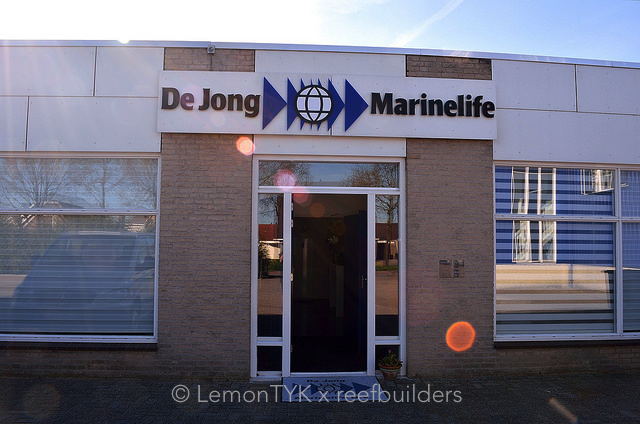There are a handful of fish and coral powerhouses spread around the world in isolation, each with their special niche and prowess responsible for procuring some of the hobby’s most sought after. Most recently on our little tour of Europe, we swung by one such establishment, notorious in their craft and embellished with the songs of praise. The family run De Jong marine is one of the heavenly kings when it comes down to the rare fish market, and our trip certainly did not disappoint.

De Jong marine is a family run corporation. Taken over by managing director Arie De Jong back in 1982, it has since grown to become Europe’s leading distributor of marine life. While specialising primarily in the supply of large sharks, rays and fish to public aquariums, De Jong marine has earned a reputation unsurpassed by many as a source for rare ornamental fish. Indeed, their namesake precedes them even in the scientific community, with their exclusively signature Gramma dejongi being named after Arie.

The facility is located in Netherlands, about an hour or two away by car from Düsseldorf Germany where we were before. Beyond the office entrance is the facility proper where corals and fish are received, held and re-exported. The establishment is neat, well manicured and very organised. Interestingly, it’s designed in a rather curious yet indescribable manner; you get a sense of déjà vu when you first walk in. Perhaps its the extensive use of shiny white tiles and strong LEDs, giving the place a rather hospital-ish feel.
Corals are held in two long raceways running parallel to each other, while fish are held in compartmentalised tanks stacked up neatly and arranged in rows, almost in a shelf like manner. The photos above helps to depict this thought. If you’re a sufferer of OCD, this place is a heavenly blend of straight lines and sections, compartments and rectangles.

Dealing heavily in the public aquarium sector, De Jong marine has an extensive housing area for large elasmobranch and fish. The high bio load of these animals coupled with the need for stringent water quality means that the facility is in need of heavy duty filtration, sterilisation and overall water chemistry management. The filtration section at the back portion of the facility is rigged with numerous industrial sized protein fractionators, sterilisers and other complicated looking equipment whose purpose to be very frank; I have no idea.
I’m not much of an equipment junkie or a plumbing fanatic, so this portion of the tour was rather unexciting for me. Fish on the other hand, makes me happy and I was indeed pleasantly delighted with what I got to see.

The main holding room for export houses 95% of livestock, and here a mixture of common to rare species adorn the neatly arranged rows of tanks. Chaetodon selene is a rather rare and unfamiliar species in the hobby. This beautiful fish is closely related to Chaetodon gardineri and C. leucopleura, but is more pearlescent in its design and less often seen. C. selene is not abundant in the wild as well, but can sometimes be seen swimming either solitarily or in pairs above rubble slopes.
Sought after species like Paracheilinus attenuatus and Prognathodes marcellae are rather common fare, but the truly scintillating species that De Jong is so well known for however are not kept here. To see those we had to take a ten minute walk into a separate building, far away from the eyes of the public and away from the more pedestrian species.

The De Jong tour would not be complete without at least getting to see the ridiculous Gramma dejongi, a basslet so beautiful and high on the bucket list of many. While Gramma dejongi is sporadically available at the cost of a couple low-thousands, it has not penetrated the American market due to the previous embargo with Cuba. With that being lifted and out of the way, perhaps this species may one day finally touch American soil. G. dejongi has been talked about incessantly in its heyday, and while there’s nothing new to cover, it’s always nice to see new photos of this truly beautiful fish.
A pair and a solitary specimen of G. dejongi is housed in this secluded room, and we’re still unsure if it’s just a happy coincidence or not, but it appears that G. dejongi may be slightly sexually dichromatic. In the pair above it’s pretty evident that the larger specimen is more rich, gearing toward a deep sunset instead of the lemony coloured individual behind. Other rarities include an Armitagei angelfish hybrid, and a group of Pseudanthias connelli.

Housed in a cold water set up were a pair of Callanthias japonicus, along with Sacura margaritacea and Caprodon schlegelii. Callanthias japonicus is a gorgeous anthiine found in the deep cold waters of Japan, and is rarely offered for the consumer market. A popular candidate for cold water Japanese biotopes, C. japonicus is more often seen in public aquariums than home hobbyists. In C. japonicus, males are a deep chrome yellow to apricot overall, with pink iridescence on the ventral fins and nape. Callanthias is deep bodied and large, with rounded median fins and a filamentous caudal fin.

These are maintained at a chilling temperature of 16C (60F), which makes viewing and photography extremely troublesome with the constant condensation and fogging of the aquarium glass. Because of their large size and penchant for cold waters, this species is not often displayed privately. Still, C. japonicus remains one of the most beautiful anthiines of its region, surpassing even the candy coloured Tosanoides.
To be able to see some of these specimens and take a tour of the facility is a treat, and De Jong marine is truly a professional and well manicured facility worthy of its title. A big thanks to Arie, Thomas and Louella De Jong for the hospitality and tour.



